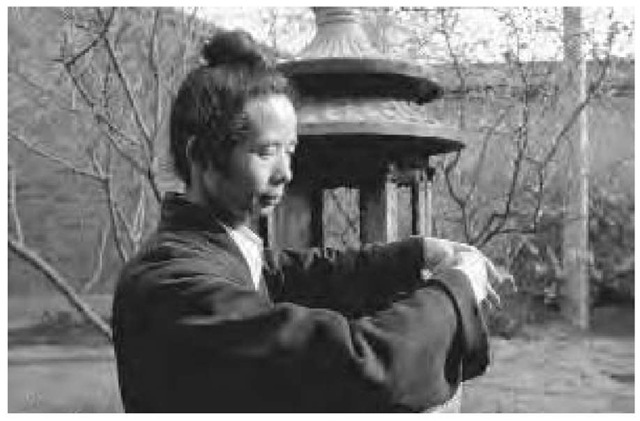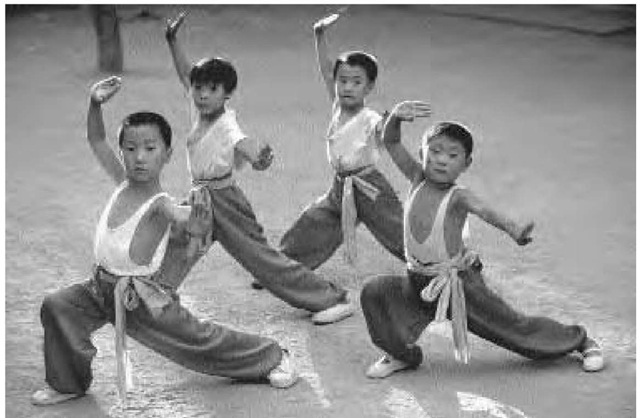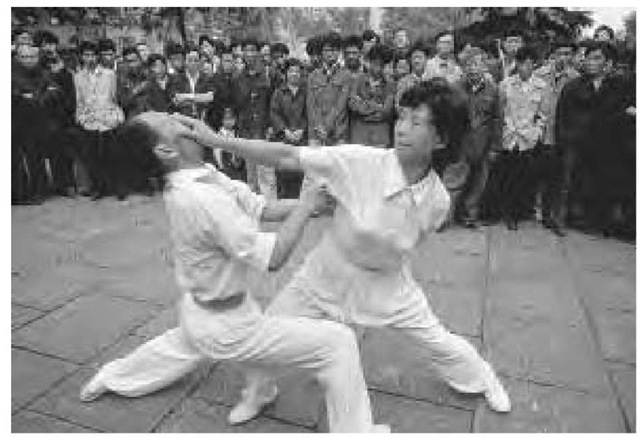In early times, a number of terms were used to describe Chinese martial arts, which are now known as wushu. The term jiangwu (teach military matters) was a comprehensive concept comprising training in general and martial arts in particular. In the state of Zhou (475-221 B.C.), jiangwu took place during the winter, while farming occupied the other three seasons. The term jiji (attack, skilled striking) was used in reference to the troops of the state of Qi (a state that occupied much of the present province of Shandong between 480 and 221 B.C.). Some have claimed that this term refers to boxing, but it more likely refers to individual hand-to-hand combat, both bare-handed and with weapons. The Han History Bibliographies of ca. a.d. 90 (Gu 1987, 205) use the term bing jiqiao (military skills).
For at least the last seven centuries, the Chinese martial arts have been primarily called wuyi, which translates directly into “martial arts” in English, and reflects skills associated with the profession of arms in Chinese. An exception is the term gongci zhi shu (attack and stabbing skills), used to describe the martial arts practices prohibited under Mongol rule. During the Qing period (1644-1911), the term quanbang (boxing and staff) was also commonly used by the Manchu regime to describe popular Han Chinese martial arts practices (group practice outside the military, primarily among the Han Chinese majority, as opposed to Manchu practices of wrestling and archery on horseback), especially those of heterodox religious groups and secret societies. In traditional Chinese society, martial arts practice was not so much spiritual as it was the equivalent of keeping firearms. These groups were often considered subversive by the authorities and, indeed, some were. For example, the Taipings, a quasi-Christian cult, grew into a major threat to the regime, occupying a large portion of southeast China between 1850 and 1863.
The term wushu as it is used today in the People’s Republic of China is only rarely seen in ancient texts. This term also translates into “martial arts” in English. The term wushu had become commonplace early in the twentieth century (possibly following the Japanese use of shu or jutsu, as in jujutsu [pliant skill]). Even the young Mao Zedong referred favorably to the Japanese practice of jujutsu (roushu in Chinese), which he carefully noted had evolved from Chinese skills.
The Nationalist government (controlled by the Nationalist Party, known as the Guomindang) adopted the term guoshu (national arts) in 1927 to associate them with modern Chinese nationalism. As a result, the term guoshuguan (national arts hall) has carried over to the present in some overseas Chinese communities.
The term kung fu (gongfu) merely means “skill” or “effort” in Chinese. In the eighteenth century, a French Jesuit missionary in China used the term to describe Chinese yogalike exercises. It was accepted for English usage in the United States during the 1960s to describe Chinese self-defense practices seen outside Mainland China as being similar to karate. It was widely popularized by the Kung Fu television series in the 1970s and is now a household word around the world. However, this term evokes a fanciful, exaggerated association of the Chinese martial arts with Shaolin Monastery and Buddhism—a distorted image of these arts, whose origins go back much further than either Buddhism in China or Shaolin Monastery.
From early times, the martial arts emphasized weapons skills. The Conversations of the States (Conversations of Qi) mentions five edged weapons: broad sword, straight sword, spear, halberd, and arrow. The Rites of Zhou also lists five weapons: halberd, lance, pike, and long and short spears. The topic of Rites includes archery, charioteering, and wrestling in the seasonal martial training regimen. In the section on music, it further describes martial dances with shield and axe and choreographed halberd and spear movements—early examples of combining ritual with martial techniques into routines commonly known in modern karate parlance as kata. The ancient Chinese aristocracy doubled as priests. Religion and governance converged; therefore, there were rites to support military as well as peacetime activities.
A Daoist priest practicing martial exercises in a temple in Beijing, China, April 1995.
The entries on archery, straight sword, boxing, and even football (more like soccer, which required considerable agility as well as endurance) in the Han History Bibliographies reveal that manuals were written on important martial arts and related skills, although those extant date back no earlier than the Ming dynasty (ca. sixteenth century). Boxing was the basic skill that supplemented weapons, and certain boxing-related techniques were used on horseback as well as on foot, especially weapons-seizing techniques. For example, General Deng Zhan of Wei (ca. a.d. 220-226) was known for his skill with the “five weapons” and for his ability to take on armed opponents empty-handed. During a campaign in a.d. 582, Sui troops, outnumbered and their “five weapons” depleted, successfully fought off a Tujue (Turkic tribe) force with their bare fists, with such ferocity that “the bones in their hands were visible” (Wang 1960, 395, 4694). General Weichi Jingde of Tang (ca. a.d. 627-649) could ride into an opposing army, dodge the enemy’s lance thrusts, seize an enemy lance, and use it against the attackers.
When the military examination system was established in 702, the martial arts emphasized for leaders were lance and spear from horseback, and archery from horseback and on foot. There was a test of strength, as well, that consisted of lifting a large city gate log bolt ten times (based on a story that Confucius had displayed great strength by lifting and placing just such a bolt) and carrying approximately five bushels of rice for a distance of twenty paces. Common soldiers were categorized based on their skills with archery, spear, halberd, pike, and sword, and their daring in hand-to-hand combat. A premium was placed on strength and endurance.
By the Song dynasty there was a saying: “There are thirty-six types of weapons, and the bow is the foremost; there are eighteen types of martial arts, and the bow [archery] is the first.” From this time on, exceptional martial artists were commonly described as “skilled in the eighteen martial arts.” One can find essentially two versions of the eighteen weapons in various sources. The matchlock is included in the eighteen weapons listed in the early Ming novel Water Margin (also known as All Men Are Brothers and Outlaws of the Marsh in English). Later Ming versions drop the matchlock and include boxing at the end of the list, perhaps influenced by General Qi Jiguang’s chapter on boxing, which is also the oldest extant illustrated Chinese boxing manual. The most common listing of the eighteen weapons includes the composite bow, crossbow, spear, broad sword, straight sword, pike, shield, arrow axe, broad axe, halberd, flail, iron rod or bar (a tapered, smooth or segmented, solid iron rod [also called "iron whip"] with a sword grip, often used in pairs), claw (metal talons attached to a cord thrown to seize and unhorse a rider), lance, trident, rake (similar to an agricultural tool), dart and cord, and boxing. This selection seems a bit arbitrary, and at least one Chinese author has noted that some of these weapons appear more suited for use in interclan feuding than in large-scale military combat. Thus, the phrase “eighteen martial arts” appears to reflect a convergence of military and popular forms. The “Song Period Essentials” from the Military Classics (Wujing Zongyao) (ca. 1044) includes illustrations of the variety of weapons used by the military.
Young children in Beijing going through basic martial arts training, November 1997.
Contemporary literature provides a peek at martial arts activities in and around the Southern Song capital, Hangzhou (1127-1279). The military forces scheduled training exercises every spring and autumn at designated locations, where, amid the crash of cymbals and beating of drums, they practiced combat formations and held archery competitions, polo matches, and numerous other martial arts demonstrations, such as spear and sword fighting.
Associations were organized among the citizenry by those interested in wrestling, archery, staff fighting, football, polo, and many nonmartial activities. Also, outdoor entertainment at certain locations in the city included wrestling matches (both men’s and women’s), martial arts demonstrations, acrobatics, and other physical displays.
Some of these activities (considered secular folk entertainment, not religious activities) could still be seen at the temple festivals (which were combination county fairs and swap meets) and other festive occasions well into the twentieth century.
Japanese swords were popular during the Ming, and both General Qi Jiguang’s New topic of Effective Discipline (Jixiao Xinshu) (ca. 1561) and Mr. Cheng’s Three Kinds of Insightful Techniques (Chengshi Xinfa Sanzhong) (ca. 1621) include illustrated Japanese sword routines to emulate. Japanese swords had begun to enter China during the Song period, when their fine quality was even described in a poem by the famed literary figure Ouyang Xiu (1007-1072). Records show that Japanese swords and poled weapons (naginata, weapons similar to the European halberd) were presented as tribute to a number of Ming-period rulers. Ming military leaders were able to observe firsthand the effectiveness of Japanese weapons and fighting techniques during the large-scale Japanese pirate activities in the Chinese coastal provinces during the mid-sixteenth century. The Chinese were suitably impressed, and the experience resulted in Chinese use of Japanese weapons as well as indigenous production of Japanese-style swords and the adoption of Japanese sword techniques.
By the Qing period (1644-1911), the Comprehensive Study of Documents (Wenxian Tongkao) reveals that, among the types of individual weapons officially produced for military use in 1756, special emphasis was placed on as many as nineteen varieties of broad swords and sixteen types of poled weapons categorized as spears—a bewildering mix facing military martial arts drill instructors.
When the Nationalist government-sponsored Central Martial Arts Institute was established in Nanjing in 1927, its founders were faced with the daunting task of attempting to satisfy the sensitivities of numerous martial arts factions within a single national program. They got off to a troublesome start by dividing the institute into Shaolin and Wudang branches. The Wudang branch included only instruction in taijiquan, xingyiquan, and baguazhang, while the Shaolin branch arbitrarily comprised all other martial arts styles. This arrangement was based on the popular belief that Chinese boxing consisted of an External or Shaolin School (Buddhist), which emphasized strength and speed, versus an Internal or Wudang School (Daoist), which emphasized use of an opponent’s strength and speed against him. This simplistic view originated with a 1669 piece titled Epitaph for Wang Zhengnan, written by the Ming patriot and historian Huang Zongxi. At the time, however, it was probably meant as a veiled political jab at the foreign Manchu regime rather than as a serious discussion of boxing theory. In any case, division of the institute into these two branches resulted in infighting, so the branches were quietly phased out.
A crowd watches as a couple stages a martial arts demonstration on a sidewalk in Shanghai, October 1983.
After 1949, traditional sports, including the martial arts, were placed under a government Physical Culture and Sports Commission. Martial arts for nationwide competition were standardized into three major categories of boxing (changquan, nanquan, and taijiquan), while weapons were limited to four basic types with standardized routines (broad sword, straight sword, staff, and spear). Changquan (long boxing) routines have combined techniques from the more acrobatic so-called northern styles of boxing, while nanquan, or “southern boxing,” has combined the “short hitting” emphasis on arm movements prominent in most styles of boxing found in South China (especially in Fujian and Guangdong provinces).
Standardized taijiquan, including a shortened routine of twenty-four forms, was based on the widely practiced Yang style of taijiquan. Many of the traditional styles continued to be practiced individually, and more liberal policies in recent years have resulted in the resurgence of some, such as the original Chen style of taijiquan.



